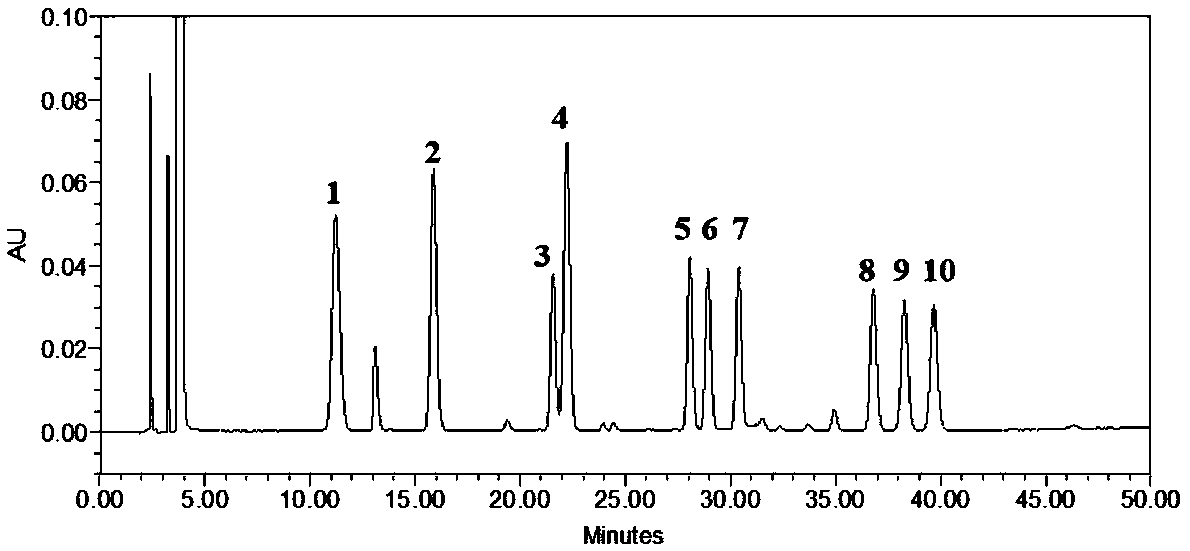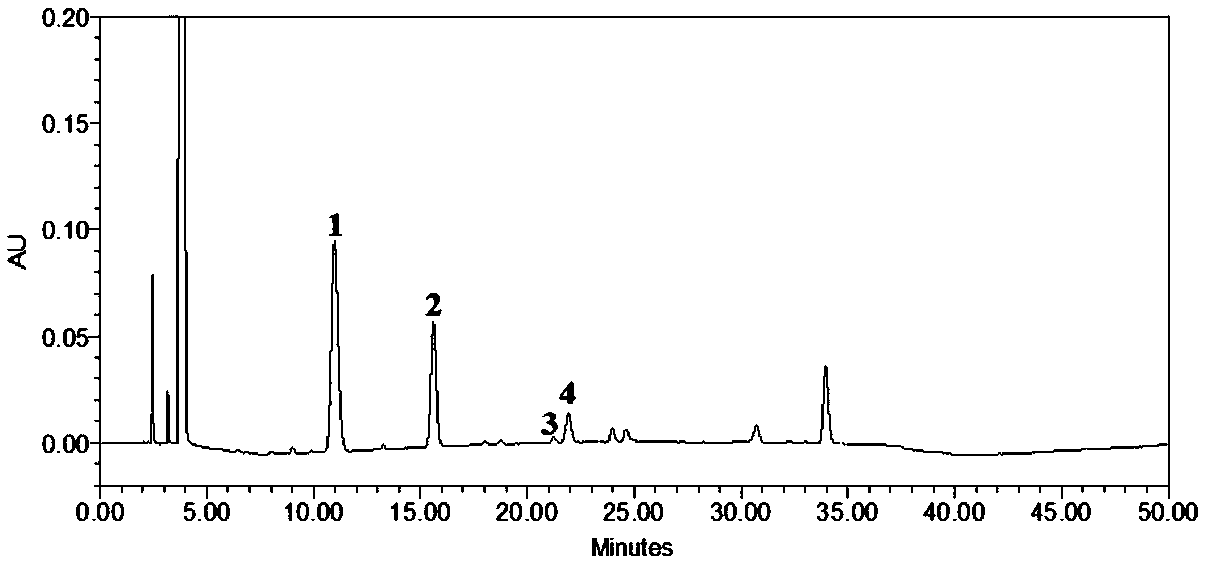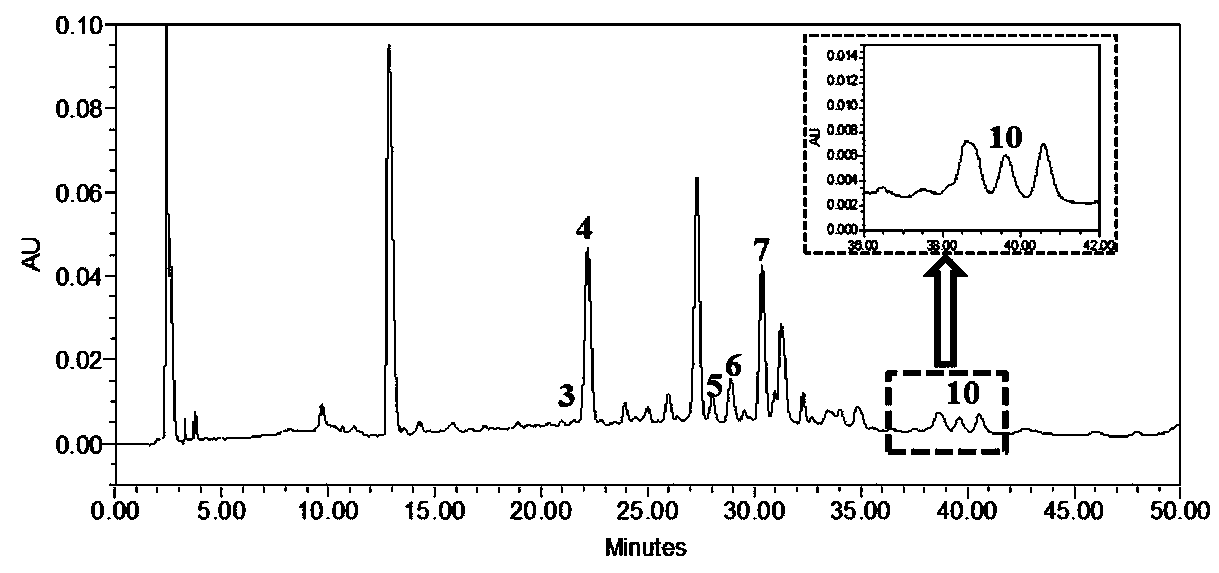Quantitative method of short-chain fatty acid
A technology for the quantitative detection of short-chain fatty acids, which is applied in the direction of measuring devices, instruments, scientific instruments, etc., can solve the problem of no detection method found, and achieve the effect of low detection cost, high precision and convenient detection
- Summary
- Abstract
- Description
- Claims
- Application Information
AI Technical Summary
Problems solved by technology
Method used
Image
Examples
no. 1 example
[0043] The quantitative method of the short-chain fatty acid of the first embodiment of the present invention comprises the following steps:
[0044] (1) Sample processing
[0045] Collect 1 part of human feces samples from 6 volunteers, weigh 2 g of feces for each sample, and vortex with 30 wt% acetonitrile aqueous solution (add 7 parts of pure water first, then add 3 parts of acetonitrile) according to the weight ratio of 1:10 Extract for 2 minutes to obtain a suspension; centrifuge the suspension at 4000rpm / min for 10min at 10°C, take 400uL of the supernatant and place it in a 5mL centrifuge tube, add 200μL of 200mM 3NPH·HCl solution and 200μL of 120mM EDC·HCl and 6wt% pyridine mixed solution were reacted together at 40°C for 45min. After the reaction, add water to make it slightly more than 1 mL, centrifuge at 13,000 rpm at 4°C for 10 min, and take the supernatant to obtain a derivatized sample;
[0046] (2) SPE cartridge enrichment
[0047] Take 1mL of the derivatized ...
no. 2 example
[0057] Second embodiment (methodological verification of the method of the present invention)
[0058] (1) Determination of linear range and detection limit
[0059] Take mixed standard solutions of short-chain fatty acids with different concentrations, and measure them according to the method in the first embodiment "sample treatment, SPE small column enrichment and liquid chromatography separation". Determine the limit of detection and the limit of quantification with signal-to-noise ratios of 3 and 10 respectively, draw a curve with the peak area of the characteristic absorption peaks of 10 short-chain fatty acids as the vertical coordinate y, and the concentration of short-chain fatty acids as the abscissa x, and obtain the detected short-chain fatty acids The linear range of , see Table 3.
[0060] Table 3 Linear regression equations and related parameters of 10 short-chain fatty acids
[0061]
[0062]
[0063] (2) Determination of stability, precision and accu...
no. 3 example
[0068] The third embodiment (determining the content of short-chain fatty acids in the human feces fermented liquid sample)
[0069] (1) Sample treatment: Collect human feces fermentation liquid samples, measure 700uL sample solution, add 300uL acetonitrile, and vortex for 2min.
[0070] (2) All the other processing steps and HPLC-UV analysis steps are the same as the first embodiment, such as Figure 4 and Figure 5 As shown, the measured content of short-chain fatty acids in the human feces fermentation broth is shown in Table 5.
[0071] Table 5 Results of quantitative detection of 10 kinds of short-chain fatty acids in human feces fermentation liquid samples
[0072]
[0073]
PUM
 Login to View More
Login to View More Abstract
Description
Claims
Application Information
 Login to View More
Login to View More - R&D
- Intellectual Property
- Life Sciences
- Materials
- Tech Scout
- Unparalleled Data Quality
- Higher Quality Content
- 60% Fewer Hallucinations
Browse by: Latest US Patents, China's latest patents, Technical Efficacy Thesaurus, Application Domain, Technology Topic, Popular Technical Reports.
© 2025 PatSnap. All rights reserved.Legal|Privacy policy|Modern Slavery Act Transparency Statement|Sitemap|About US| Contact US: help@patsnap.com



